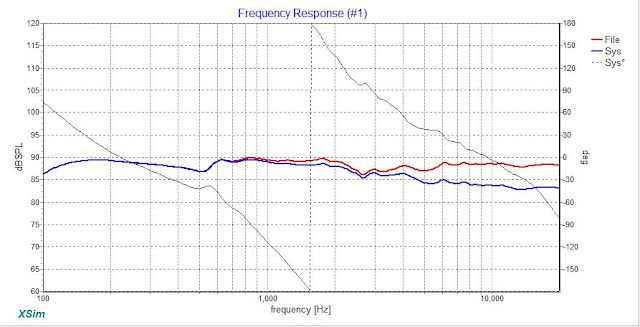Variable L-pads are sometimes used as a form of equalisation, although they shouldn't be used that way. Correctly blending the drivers at the crossover can happen even when the room tonal balance isn't right.. that aspect should be taken care of using a (conceptually) external contour. I only bring this up due to the effort of finding the ideal variable attenuator, but once the optimum values have been found they can be replaced with fixed resistors and any remaining crossover blending issues are the fault of the speaker design. (This is not to mention the crossover speaker/l-pad impedance variable interactions unless one or the other is buffered.)
Hi Frangus,
I personally hate the idea of rotary pots on anything with current on it, so I think a switch idea is a far more reasonable approach.
Instead of a rotary attenuator though, a multi-position switch would work. Here's an example of FR plot range from the LM-1 project. You can see how the change in R from 0.5 to 5 Ohms changes the output. I would simulate it, or find a range and then pick a few good values. Like for the LM-1 I might do 0.5, 3 and 5 Ohms. To figure out what would work for you though you have to know your crossover.

Personally I find this approach much more satisfying than swapping cables or amps endlessly to find the magic balance.
Best,
Erik
I personally hate the idea of rotary pots on anything with current on it, so I think a switch idea is a far more reasonable approach.
Instead of a rotary attenuator though, a multi-position switch would work. Here's an example of FR plot range from the LM-1 project. You can see how the change in R from 0.5 to 5 Ohms changes the output. I would simulate it, or find a range and then pick a few good values. Like for the LM-1 I might do 0.5, 3 and 5 Ohms. To figure out what would work for you though you have to know your crossover.

Personally I find this approach much more satisfying than swapping cables or amps endlessly to find the magic balance.
Best,
Erik
Last edited:
Changing the level of one driver upsets the balance with a step around the crossover. Adding tone control should be done equally to each driver, so that there isn't a step and so they remain properly blended, the simplest example being an active equaliser.Thanks Allen
A friend has requested it to allow fine tuning for different recordings / genres
Im not quite sure what you mean by "external contour"
Of course this also has to be done once to finish a passive crossover, for example applying a selected 'additional' curve to set the standard 'in room' tone, which should be done independently to each crossover section (say, mid and tweet), after (in addition to) the initial blending.
Changing the level of one driver upsets the balance with a step around the crossover. Adding tone control should be done equally to each driver, so that there isn't a step and so they remain properly blended, the simplest example being an active equaliser.
Of course this also has to be done once to finish a passive crossover, for example applying a selected 'additional' curve to set the standard 'in room' tone, which should be done independently to each crossover section (say, mid and tweet), after (in addition to) the initial blending.
Easy to do with DSP but not ao easy with passive !
Fair call, but it's not that hard really. Here's how I've done it:
1) Starting with a default optimised crossover, use tone controls to EQ the rolloff to taste. Measure the EQ curve.
2) Import it into speaker workshop then add it to a shot of the crossed driver curves. Using this as an overlay/target, change the crossover.
1) Starting with a default optimised crossover, use tone controls to EQ the rolloff to taste. Measure the EQ curve.
2) Import it into speaker workshop then add it to a shot of the crossed driver curves. Using this as an overlay/target, change the crossover.
There is an art to winding transformers. I like transformers. Resistors are the perfect place to begin, of course, and they will be better than a poorly specified transformer.So.... your saying a resistor is a much better idea?
- Status
- This old topic is closed. If you want to reopen this topic, contact a moderator using the "Report Post" button.
- Home
- Loudspeakers
- Multi-Way
- Stepped attenuator in lieu of L pad
